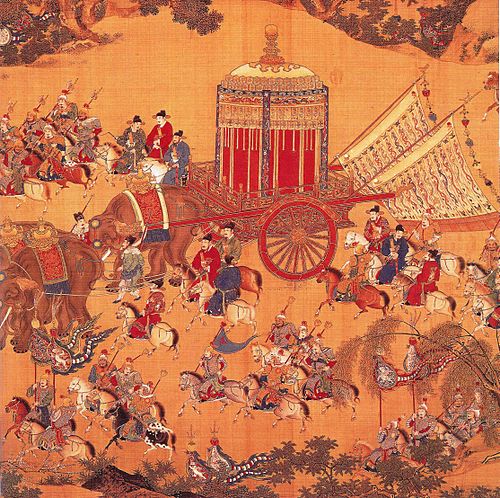Our research team is organized into four thematic clusters that collectively transcend individual expertise, producing original research of unparalleled scope and depth of knowledge.
HIGHLIGHT RESEARCH 
We decompose population growth in 19th century Liaoning in northeast China into the shares accounted for by different socioeconomic groups, and by time periods with different economic conditions as reflected in grain prices. This decomposition reveals who benefitted the most when social and economic conditions supported population increase. Previous studies of one region for which relevant data are available, northeast China, showed that birth and death rates varied according to community, household, and individual context, but did not investigate differences in growth rates by context, or the shares of population growth accounted for by each group. Using the same dataset, we decompose population growth by synthesizing differentials in mortality and fertility into estimates of implied growth rates of population subgroups and the shares of total population growth they account for. This decomposition framework can be applied in any setting where household registers or other sources allow for the measurement of the mortality and fertility rates of population subgroups at fixed points of time. We show that advantaged socioeconomic groups contributed disproportionately to population growth in northeast China, and that more growth took place when harvests were good, that is when grain prices were low. Even though mortality and fertility responses to grain price fluctuations varied across subgroups, there is no evidence of differential response of growth rates to these fluctuations. We conclude by discussing the implications of our findings for our understanding of population dynamics in the late Qing.


本文首先考證了明代河南漕糧交兌點在㆕個㆞點間的六次往返變換,並通過這種變換說明河南漕糧交兌這㆒經濟活動對小灘鎮和大名府的依賴。其次,本文通過對大名府軍屯數量以及軍屯兼併情況的考證,說明了大名府㆞方社會、政治空間的「犬牙相入」,並展現了被拋棄的腹㆞是如何通過軍屯參漕糧交兌和邊糧供給這兩大經濟活動㆗。最後,通過大部分河南漕糧的對撥目的㆞由薊州鎮變為通、太㆓倉這㆒歷史進程,亦能㆒窺實物型財政亦或洪武型財政的逐漸崩壞。


This study exploits a special historical case-openings of treaty ports in 19th-century China to examine how upper-tail human capital, quantified via book creation, impacted modernization when facing external pressures. Employing a prefecture-level panel dataset from 1840 to 1904, the study establishes book density, indicative of knowledge endowment, as a significant and positive predictor of modern firm entry following the opening of treaty ports. To understand the mechanism, a critical aspect lies in understanding the Civil Service Examination (keju), an indigenous institution that historically dominated talent accumulation and allocation in China. By integrating data with keju, we find that exposure to Western influence mobilized the segment of upper-tail human capital at the bottom or outside of the keju system into entrepreneurship. This paper illustrates the dynamics between indigenous institutions and external pressures.


This paper examines the transition from limited to open-access societies, focusing on early and high-Tang China (618–906). Using a dataset of 1,261 marriages from 618 to 755, we find that Empress Wu’s rise to power in 674—the first and only female emperor in Chinese history—positively impacted upward mobility. After 674, men from common and poor clans were more likely to marry into elite clans. This increase in inter-class marriages was primarily driven by Empress Wu’s expansion of national civil examinations, which strengthened her legitimacy and created new opportunities for social advancement.


Christian missionaries are shown to have contributed to the historical rise of international trade by bridging the information gap between Europe and unfamiliar overseas lands from the 16th century onward. To prove that they unintentionally mitigated information barriers for early traders, we focus on the experience of historical China where European missionaries arrived from 1580 onward but maritime foreign trade was largely banned between 1371 and 1842. Our analysis demonstrates that following China’s forced opening for international trade in 1842, regions with longer past missionary presence typically bought foreign goods earlier, imported more in terms of both value and goods diversity, and exported more local products, as these places had more foreign interactions and appeared more frequently in the missionaries’ letters and publications back in Europe. Our findings substantiate the importance of the information channel through which the missionaries accelerated trade globalization.


Extracting geographic information from historical texts presents unique challenges. To address these challenges, this study leverages generative large language models (LLMs) to extract historical toponyms and their corresponding location references from texts. The coordinates of the extracted toponyms are then identified by a historical geocoder, which also calculates their maximum error distances based on the location references, indicating the degree of uncertainty. Both the extraction and geocoding processes are integrated into a novel tool named ‘His-Geo’ (https://github.com/yukiyuqichen/His-Geo). To evaluate the results, this study also curates a manually annotated dataset, the Early China Historical Geographic Corpus (CHGC-Early), filling the gap in the absence of geographic data for early China in existing gazetteers and providing a benchmark dataset for training and evaluating approaches for tasks related to geographic information extraction from premodern Chinese texts. The evaluation results show a satisfactory 0.831 F1 score for the GPT-4o model, demonstrating the remarkable capability of generative large language models in extracting geographic information from lengthy, unstructured texts that encompass diverse and sometimes conflicting views.


量化歷史和數字人文是近年來快速發展的交叉學科。 在大數據、人工智能時代,兩者都促進了人文學科的發展。 同時,量化歷史研究跟數字人文兩者之間也是相互促進、互為補充的。 與數位人文相比,量化歷史的重點集中在資料庫的利用,特別是結合量化分析方法、社會科學理論來研究重要的歷史現象,發現其中的規律、驗證因果關係並提供系統解釋。 也就是說,數字人文一般是基於數據對現象之間的相關性做出估算、判斷,而量化歷史研究則更進一步探究歷史現象之間的因果關係並從統計學上做系統驗證。 隨著更多歷史資料庫的建立並為學界開放,量化分析方法的應用也隨之增加,變得更為廣泛。


China’s center of socioeconomic activities was in the North prior to the Tang dynasty but is in the South today. We demonstrate that Arab and Persian Muslim traders triggered that transition when they came to China in the late seventh century, by lifting maritime trade along the South Coast and re-creating the South. Between 742 and 1393 CE, prefectures with better access to maritime trade, or higher porcelain trade participation, experienced significantly higher population growth, but the predictive coefficient weakened substantially after the maritime trade ban of 1371 CE. These findings are robust after controlling for many confounding factors.


當前,對人工智能造成的衝擊,歷史學者的態度並不一致,或熱烈擁抱,或批判吸收,或警惕反思,總體而言,是在被動地回應。 但是,僅僅被動回應是不夠的。 歷史學及其理論不僅應當重視人工智能,更應該介入和影響其發展。 早在1976年,約瑟夫·魏岑鮑姆(Joseph Weizenbaum)就提出,歷史學有必要介入人工智能,特別是保存那些無法成為人工智能輸入數據的史料。 2019年,在斯坦福大學成立了「以人為本的人工智能」研究所,該研究所認識到,人工智能在改善人類狀況方面有著非凡前景,但前提是能夠成功引導其朝著負責任的方向發展。 為達此目的,研究所吸納了不少歷史學者和其他人文學者。 這一機構之所以能贏得人工智能領域的世界級聲譽,正是其理念和舉措的結果。 近年來,也有中國學者注意到這個問題,主張將知識、技能、感性經驗、價值觀念融入數位人文研究方法,其中包括人工智能的方法,惜未充分展開。
歷史學及其理論之所以能夠介入和影響人工智能,特別是當前代表人工智能前沿方向的大語言模型(以下簡稱「大模型」)的發展,很重要的一個因素在於兩者之間工作原理的相似和相通性。 在一定意義上說,歷史學就是用語言將「數據、記憶、關於過去的證據性遺迹、文獻和遺物」變成歷史的自覺省思。 大模型實際上是對人類社會積累的語言材料的吸收和綜合,或者說,是以兼收並蓄、有時可能是雜亂無章的方式吸收綜合其可以獲得的所有文本。 由此可見,大模型的工作方式與歷史學者的研究存在很大的相似性,即基於過去的各種史料,進行加工和提煉,從而獲得比較系統化的知識。 正如約書華·斯特恩菲爾德(Joshua Sternfeld)所說,收集模型的訓練數據就像是收集史料,模型根據輸入產生輸出就像是根據證據產生歷史,總而言之,「我們越是深入人工智能(大模型)學習的過程,事實上,這個過程就開始和做歷史研究的工作越發相似」。
因此,歷史學及其理論與人工智能(大模型)之間存在深度交融的可能和必要,但具體如何實現,既需要認識前者,也需要深入瞭解後者的運作機理。






